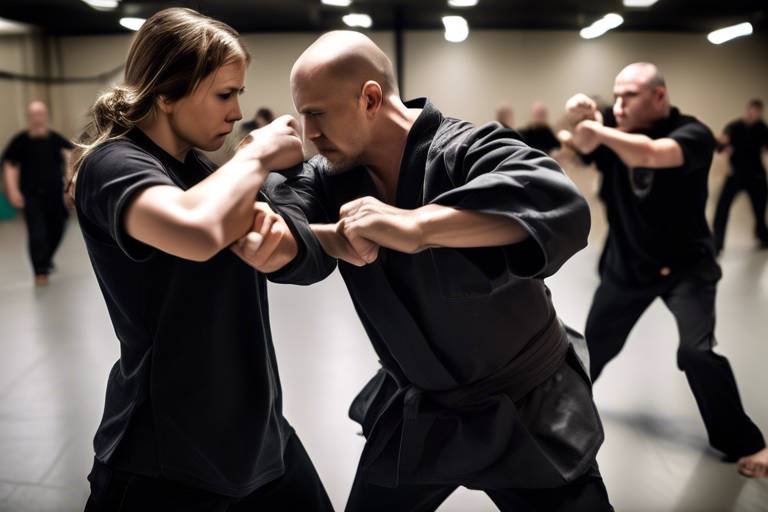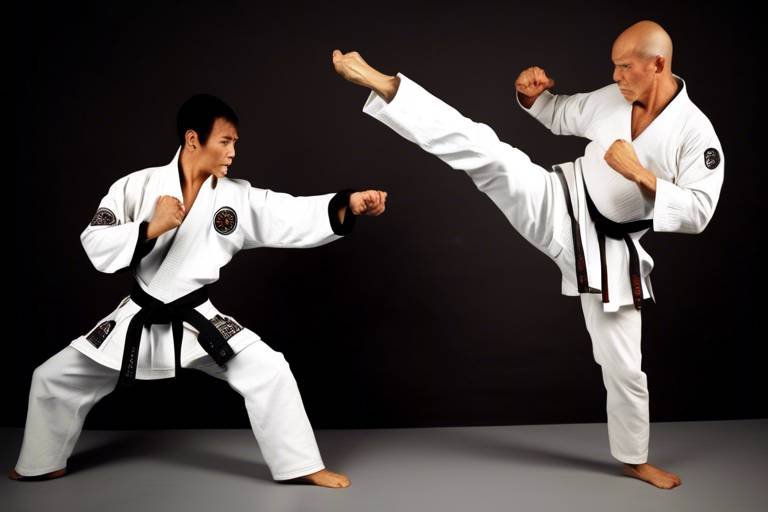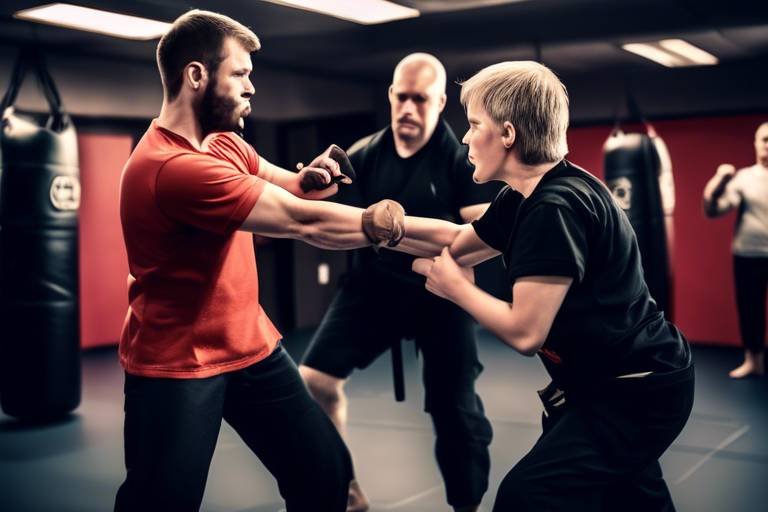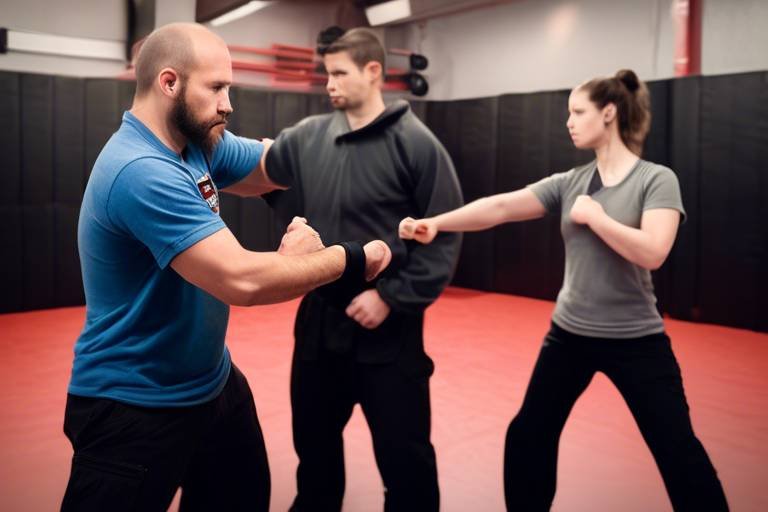Five Simple Tech Tips to Augment Your Self-Defense Training Program
This article explores practical technology-driven strategies to enhance your self-defense training. Discover how the right tools can boost your skills, awareness, and preparedness in various situations.
Fitness apps are like personal trainers in your pocket! They not only track your progress but also provide structured workouts tailored specifically for self-defense. Imagine having a coach guiding you through each move, pushing you to your limits, and keeping you accountable. With a plethora of options available, you can choose apps that offer tailored routines focusing on strength, agility, and flexibility—all crucial for self-defense. Plus, many of these apps come with motivational features that encourage you to stay on track. So, whether you’re a beginner or a seasoned fighter, there's something for everyone. Why not download one today and start your journey towards becoming a self-defense ninja?
Virtual reality (VR) has revolutionized the way we train for self-defense, offering immersive experiences that simulate real-life scenarios. Picture this: you’re in a controlled environment, facing a virtual attacker. With VR, you can practice your moves, improve your reaction times, and enhance your decision-making skills without the risks associated with real-life encounters. It’s like stepping into a video game where you are the hero! But it's essential to choose the right VR programs to ensure effective training.
Selecting appropriate VR programs is crucial for effective training. Look for options that focus on self-defense techniques and situational awareness. Programs that allow you to practice various scenarios—like escaping from grabs or defending against multiple attackers—are invaluable. The more realistic the situation, the better prepared you’ll be. Always read reviews and maybe even try demos to find what works best for you.
One of the standout benefits of VR training is its ability to enhance muscle memory and spatial awareness. By practicing movements repetitively in realistic scenarios, you’re not just memorizing techniques; you’re ingraining them into your muscle memory. This means when the time comes to defend yourself, your body will react instinctively. It’s like learning to ride a bike—once you’ve got it, you never forget!
However, while VR can be beneficial, it’s essential to understand its limitations. It may not fully replicate the physicality of real-life encounters, such as the unpredictability of an actual attack or the adrenaline rush that comes with it. Therefore, it’s vital to balance your VR training with real-world practice to ensure you’re well-rounded and prepared for anything.
Online tutorials are another fantastic resource for self-defense training. They provide access to expert techniques and strategies that can supplement your training. Imagine sitting at home, watching a seasoned martial artist demonstrate a complex move. You can pause, rewind, and practice at your own pace, introducing new concepts and refining your existing skills. It’s like having a personal mentor right at your fingertips!
Wearable devices have become a game-changer in monitoring fitness levels, and they can significantly enhance your self-defense training. These gadgets can track your heart rate, calories burned, and activity levels during workouts. By analyzing this data, you can optimize your training sessions and track improvements over time. Think of it as having a fitness assistant that keeps you informed about your body’s performance.
Selecting the right wearable technology is key to enhancing your training. Look for devices that offer features specifically designed for physical fitness and self-defense. Some wearables provide insights into your recovery times, sleep patterns, and even stress levels, all of which can impact your training effectiveness. The right device can help you stay motivated and on track, ensuring you’re always improving.
Understanding the data collected from wearables can help you identify strengths and weaknesses in your training routine. For example, if your heart rate spikes too quickly during drills, it might indicate a need for better conditioning. By analyzing this data, you can make targeted improvements, ensuring that every training session counts. It’s like having a personal coach who’s constantly evaluating your performance and helping you grow!
- What are the best fitness apps for self-defense training? There are numerous apps available, but popular choices include MyFitnessPal, StrongLifts, and JEFIT, which offer tailored workouts and tracking features.
- Can VR really help me in real self-defense situations? Yes, VR can enhance your reaction times and decision-making skills, but it should be complemented with real-world practice.
- What should I look for in a wearable device? Choose wearables that monitor heart rate, activity levels, and recovery metrics, specifically designed for fitness and self-defense training.
- Are online tutorials effective for learning self-defense? Absolutely! They provide access to expert techniques and allow you to learn at your own pace.

Utilizing Fitness Apps
In today's fast-paced world, fitness apps have become an essential tool for anyone serious about self-defense training. Imagine having a personal trainer in your pocket, guiding you through workouts, tracking your progress, and keeping you motivated. These apps can do just that! They not only offer structured workouts tailored specifically to self-defense techniques, but they also provide a platform to set goals and measure improvements over time. By utilizing these digital resources, you can enhance your training experience and stay accountable to your regimen.
Many fitness apps come equipped with features that allow you to customize your workouts based on your skill level and specific self-defense goals. For instance, if you’re focusing on striking techniques, you can find apps that include targeted drills and exercises designed to improve your punching and kicking skills. Not only does this make your training more effective, but it also adds an element of fun and variety to your routine. You’re less likely to get bored when you have a new workout to look forward to each day!
Moreover, many fitness apps integrate social features that allow you to connect with fellow practitioners. This sense of community can be incredibly motivating. You can share your achievements, participate in challenges, and even get tips from others who are on the same journey. It’s like having a training buddy, but virtually! This interaction fosters a sense of camaraderie and can push you to achieve more than you might on your own.
To give you an idea of what to look for in a fitness app, here’s a quick comparison table of some popular options:
| App Name | Features | Cost |
|---|---|---|
| Self-Defense Workout Pro | Custom workouts, progress tracking, video tutorials | Free with in-app purchases |
| Fitify | Personalized training plans, community challenges | $9.99/month |
| MyFitnessPal | Nutrition tracking, workout logging | Free with premium options |
When selecting a fitness app, consider your personal training style and what features will be most beneficial for your self-defense practice. Do you prefer guided workouts, or do you thrive on tracking your own progress? Whatever your preference, there's likely an app that fits your needs perfectly. By incorporating fitness apps into your training regimen, you can significantly enhance your skills, maintain your motivation, and ultimately become more prepared for any situation.

Incorporating Virtual Reality
When it comes to self-defense training, incorporating Virtual Reality (VR) can be a game-changer. Imagine stepping into a digital world where you can practice your skills without the risks associated with real-life sparring. VR offers an immersive experience that simulates various self-defense scenarios, allowing you to react and adapt in a controlled environment. This technology can significantly enhance your training by providing a safe space to make mistakes and learn from them, all while keeping your heart racing and your adrenaline pumping.
One of the most exciting aspects of VR training is its ability to create realistic situations that you might encounter in real life. Whether you're facing an aggressive attacker in a dark alley or trying to diffuse a tense situation, VR can replicate these environments in stunning detail. This not only helps improve your reaction time but also sharpens your decision-making skills under pressure. Instead of just going through the motions in a traditional class, you can engage with a virtual opponent, making your training more dynamic and engaging.
But how do you choose the right VR programs for your self-defense training? It’s essential to focus on options that emphasize self-defense techniques and situational awareness. Look for programs that offer a variety of scenarios, ensuring you can practice different techniques and strategies. Programs that allow you to customize scenarios based on your skill level can also help you progress at your own pace. Here’s a quick comparison of some popular VR platforms that cater to self-defense training:
| VR Platform | Features | Price Range |
|---|---|---|
| VR Self-Defense Academy | Realistic scenarios, expert tutorials, progress tracking | $29.99/month |
| Combat VR | Multiplayer options, customizable training, feedback system | $19.99/month |
| Fight Simulator | Variety of combat styles, situational drills, fitness integration | $24.99/month |
In addition to improving your skills, VR training can also foster a sense of community. Many platforms offer multiplayer options, allowing you to train with friends or connect with other self-defense enthusiasts. This communal aspect can make training more enjoyable and motivate you to stick with your program. After all, who doesn’t want to spar with a buddy or share tips on how to tackle a challenging scenario?
While the benefits of VR training are substantial, it’s crucial to recognize its limitations. VR cannot fully replicate the physicality of real-life encounters. The feeling of an opponent’s weight, the unpredictability of a real attack, and the emotional stress of a confrontation are elements that VR struggles to emulate completely. Therefore, it’s essential to use VR as a supplement to your training rather than a replacement. Balancing VR practice with traditional training methods—like sparring with a partner or attending self-defense classes—will provide a more comprehensive skill set.
In summary, incorporating Virtual Reality into your self-defense training can provide an exciting and effective way to enhance your skills. By choosing the right programs, practicing in realistic scenarios, and balancing VR with traditional training methods, you can prepare yourself for real-world encounters like never before. So, why not take the plunge into the virtual world and elevate your self-defense game?
Q: Can I use VR for self-defense training at home?
A: Absolutely! Many VR platforms are designed for home use, allowing you to train whenever you want.
Q: Do I need special equipment for VR training?
A: Yes, you will need a VR headset and compatible controllers. Some programs may have specific requirements, so check before purchasing.
Q: How often should I practice with VR?
A: Consistency is key! Aim for regular sessions, ideally a few times a week, to see significant improvements.
Q: Is VR training suitable for beginners?
A: Yes! Many VR self-defense programs cater to all skill levels, making it a great option for beginners looking to learn the basics.

Choosing the Right VR Programs
When it comes to enhancing your self-defense training through virtual reality, selecting the right VR programs is crucial. Not all VR experiences are created equal, and some may not cater specifically to the skills you want to develop. To make the most out of your investment, consider the following criteria when evaluating VR programs:
- Focus on Self-Defense Techniques: Look for programs that specifically teach self-defense moves, situational awareness, and conflict resolution. These should include scenarios that allow you to practice techniques like blocking, striking, and escaping holds.
- Realistic Scenarios: The more lifelike the scenarios, the better prepared you will be for real-world situations. Programs that simulate various environments—like streets, parks, or crowded places—can help you adapt to different contexts.
- User Reviews and Ratings: Before diving in, check out reviews from other users. Their experiences can provide insights into the effectiveness of the program and whether it truly enhances training.
- Customization Options: Some programs allow you to tailor your training sessions, focusing on specific skills or difficulty levels. This flexibility can help you progressively challenge yourself and track your improvement.
Additionally, consider programs that offer a community aspect, where you can connect with other users. Engaging with fellow trainees not only keeps motivation high but also allows you to share tips and strategies, enriching your learning experience. Remember, the goal is to find a program that aligns with your training objectives, whether you’re a beginner or looking to refine advanced techniques. By making an informed choice, you can significantly enhance your self-defense capabilities and ensure that your VR training is both effective and enjoyable.

Benefits of VR Training
When it comes to self-defense training, the benefits of virtual reality (VR) are nothing short of revolutionary. Imagine stepping into a digital world where you can practice your moves without the risks associated with real-life sparring. VR training allows you to immerse yourself in lifelike scenarios that challenge your skills and instincts. This kind of training is akin to a flight simulator for pilots; it prepares you for real situations without the dangers of actual confrontation.
One of the most significant advantages of VR training is its ability to enhance muscle memory. By repeatedly practicing techniques in a virtual environment, you can improve your reflexes and responses. This repetition is crucial because, in high-stress situations, your body often defaults to what it has practiced the most. VR helps create those neural pathways that lead to quicker, more instinctive reactions.
Another benefit is the improvement of spatial awareness. In self-defense, understanding your surroundings is vital. VR training places you in various environments, helping you learn how to navigate and react to different spaces. Whether you’re in a crowded bar or an open park, practicing in VR can teach you to assess threats and identify escape routes effectively.
Additionally, VR training can be tailored to simulate specific scenarios you might face. For example, you could find yourself practicing against an aggressor in a dark alley or learning how to handle multiple attackers. This versatility makes your training more comprehensive and prepares you for a wide range of situations. Here’s a quick rundown of some key benefits:
- Enhanced Muscle Memory: Repetitive practice leads to quicker reflexes.
- Improved Spatial Awareness: Learn to navigate various environments effectively.
- Scenario Simulation: Tailor your training to specific self-defense situations.
Moreover, VR training can be a motivational tool. It adds an element of fun and excitement to your practice sessions, which can sometimes feel monotonous. Engaging with VR can transform your training from a chore into an enjoyable experience, keeping you motivated to continue improving your skills.
Lastly, VR training can be particularly beneficial for those who may feel intimidated by traditional self-defense classes. The comfort of practicing in a private space, free from judgment, allows individuals to learn at their own pace. This can be especially empowering for beginners who are just starting their self-defense journey.
In conclusion, the integration of VR technology into self-defense training offers a plethora of benefits. From enhancing muscle memory and spatial awareness to providing tailored scenarios and boosting motivation, it represents a major leap forward in how we approach personal safety training. So, if you’re looking to elevate your self-defense skills, consider stepping into the virtual realm!
Q: Can VR training replace traditional self-defense classes?
A: While VR training offers many benefits, it should complement, not replace, traditional classes. Real-life interactions and physical sparring are essential for developing practical skills.
Q: Is VR training suitable for beginners?
A: Absolutely! VR training can be very beneficial for beginners, as it allows them to practice techniques in a comfortable environment without the pressure of a physical class.
Q: Do I need special equipment for VR training?
A: Yes, you will need a VR headset and compatible software. Some programs may require additional accessories for a more immersive experience.

Potential Limitations of VR
While Virtual Reality (VR) offers an exciting and innovative approach to self-defense training, it is essential to recognize its potential limitations. One of the most significant drawbacks is that VR cannot fully replicate the physicality of real-life encounters. In a real-world situation, the unpredictability of an opponent's actions and the environmental factors at play can create challenges that a virtual environment might not accurately simulate. For instance, the weight and resistance of an actual person during a confrontation cannot be mimicked in a VR setting.
Moreover, VR training often requires a significant investment in technology, including headsets and motion sensors. This can be a barrier for many individuals who want to enhance their self-defense skills but may not have the budget for such equipment. Additionally, while VR can provide valuable visual and auditory cues, it may lack the tactile feedback necessary for developing a comprehensive understanding of physical techniques.
Another limitation is the risk of over-reliance on technology. While VR can enhance training, it should not replace traditional methods that involve real-life sparring and practice with partners. The nuances of body mechanics, timing, and distance are best learned through physical interaction. Therefore, it’s crucial for practitioners to balance their VR training with hands-on experience to ensure they are well-prepared for actual self-defense situations.
In summary, while VR provides a unique and engaging way to improve your self-defense skills, it is important to be aware of its limitations. By understanding these constraints, you can make informed decisions about how to incorporate VR into a broader training regimen that includes practical, real-world experience.
- Can VR training replace traditional self-defense classes? No, while VR offers valuable training opportunities, it should complement, not replace, traditional methods.
- Is VR training suitable for beginners? Yes, VR can be a great way for beginners to learn the basics in a controlled environment.
- How much does VR equipment cost? Prices can vary widely, but basic VR setups can start from a few hundred dollars.
- Can VR help with anxiety in self-defense situations? Yes, practicing in a virtual environment can help build confidence and reduce anxiety.

Integrating Online Tutorials
In today's digital age, the power of online tutorials is at your fingertips, and they can significantly enhance your self-defense training program. Imagine having access to expert instructors and diverse techniques without the constraints of time or location. Online tutorials offer a wealth of knowledge that can supplement your training, introducing you to new concepts and refining your existing skills. Whether you're a beginner or an experienced practitioner, these resources can provide valuable insights that can propel your self-defense journey forward.
One of the greatest advantages of online tutorials is their flexibility. You can learn at your own pace, revisiting complex techniques as many times as needed until you feel confident. This is particularly beneficial for mastering intricate moves or understanding the nuances of self-defense strategies. Additionally, you can choose tutorials that align with your specific interests, whether it’s striking techniques, grappling, or situational awareness. The variety available means you're not limited to a single instructor's perspective, which can enrich your training experience.
To make the most out of online tutorials, consider the following tips:
- Research reputable sources: Look for tutorials created by certified instructors or well-known martial artists. This ensures that you're learning correct and effective techniques.
- Engage with the content: Don’t just passively watch the videos. Take notes, practice the techniques, and even record yourself to track your progress.
- Join online communities: Many platforms offer forums or groups where you can discuss techniques, ask questions, and share experiences with fellow learners.
Moreover, many platforms provide interactive features, such as quizzes and discussion boards, which can enhance your learning experience. You can test your knowledge and engage with others who are on the same journey as you. This sense of community can be incredibly motivating, pushing you to stay committed to your training regimen.
Incorporating online tutorials into your self-defense training is not just about learning techniques; it’s about building a comprehensive understanding of self-defense principles. This holistic approach will not only improve your physical skills but also enhance your mental preparedness. Remember, self-defense is as much about awareness and decision-making as it is about physical prowess. Online tutorials can help you cultivate this mindset, preparing you for various situations you may encounter in real life.
As you integrate these resources into your training routine, keep an open mind and be willing to adapt your techniques. The world of self-defense is ever-evolving, and staying informed through online tutorials can give you an edge in your training and preparedness.
Q: How do I choose the right online tutorial for my self-defense training?
A: Look for tutorials by certified instructors, check reviews, and ensure the content aligns with your specific training goals.
Q: Can I rely solely on online tutorials for my self-defense training?
A: While online tutorials are a fantastic resource, it's essential to complement them with practical, hands-on training with a qualified instructor.
Q: How often should I practice the techniques I learn from online tutorials?
A: Consistency is key. Aim to practice regularly, ideally several times a week, to reinforce what you've learned and build muscle memory.

Leveraging Wearable Technology
In today's fast-paced world, wearable technology has become a game-changer, especially in the realm of self-defense training. These devices, which can be worn on the body, offer a plethora of features that can significantly enhance your training experience. Imagine having a personal coach on your wrist, constantly providing you with feedback and insights about your performance. With wearables, you can monitor essential metrics such as heart rate, calories burned, and even your activity levels during training sessions. This data is invaluable as it allows you to optimize your workouts and track improvements over time.
One of the most exciting aspects of wearable technology is its ability to provide real-time feedback. For instance, if you're practicing self-defense techniques, a wearable can alert you if your heart rate spikes too high or if you're not moving enough during your drills. This kind of information can help you adjust your training on the fly, ensuring that you are always pushing your limits while maintaining safety. Furthermore, many wearables come equipped with GPS tracking, allowing you to analyze your movement patterns during training. This feature is particularly useful for self-defense scenarios where spatial awareness is crucial.
When it comes to choosing the right wearable technology, there are several key factors to consider. Look for devices that not only track your physical activity but also offer features tailored specifically for self-defense and martial arts training. For example, some wearables come with built-in coaching programs that guide you through various techniques and drills, ensuring you get the most out of your practice sessions. Additionally, consider the battery life and durability of the device, as you want something that can withstand the rigors of intense training.
To give you a clearer picture, here’s a quick comparison of popular wearable technologies that could benefit your self-defense training:
| Device | Key Features | Price Range |
|---|---|---|
| Fitbit Charge 5 | Heart rate monitor, GPS, sleep tracking | $150 - $180 |
| Apple Watch Series 7 | Heart rate monitor, ECG, fitness tracking | $399 - $749 |
| Garmin Forerunner 245 | Advanced running metrics, GPS, training plans | $300 - $350 |
By leveraging wearable technology in your self-defense training, you’re not just enhancing your physical capabilities but also developing a deeper understanding of your body and its responses. This knowledge is crucial when facing real-life situations, as it allows you to remain calm and collected under pressure. So, if you're serious about improving your self-defense skills, investing in a quality wearable device could be one of the best decisions you make.
- What are the benefits of using wearable technology in self-defense training?
Wearable technology provides real-time feedback, tracks physical metrics, and helps optimize workouts, making it easier to identify strengths and weaknesses.
- Can wearables replace traditional training methods?
No, while wearables enhance training, they should complement traditional methods rather than replace them. Real-life practice is essential.
- What features should I look for in a wearable for self-defense training?
Look for heart rate monitoring, GPS tracking, activity tracking, and any built-in coaching or training programs tailored for martial arts.

Choosing the Right Wearables
When it comes to enhancing your self-defense training, choosing the right wearable technology can make a world of difference. With so many options available, it’s essential to focus on devices that align with your specific training goals. Think of wearables as your personal training partners—they’re there to provide insights and keep you accountable, but only if you pick the right ones!
First, consider the features that matter most for your self-defense training. For instance, heart rate monitoring is crucial as it helps you understand how your body reacts during intense training sessions. A device that tracks your heart rate variability can also give you insights into your recovery and overall fitness level. Additionally, look for wearables that offer GPS tracking; this feature can be beneficial if you’re practicing outdoor self-defense techniques or running drills in various environments.
Another aspect to consider is the durability of the device. Self-defense training can be rigorous, and you don’t want your tech to give out on you mid-session. Opt for wearables that are designed to withstand sweat, impact, and various weather conditions. Many brands offer rugged designs that can handle the demands of an active lifestyle, so don’t hesitate to prioritize durability.
Furthermore, compatibility with other apps is a game-changer. Some wearables sync seamlessly with fitness apps, allowing you to analyze your performance data in one place. This integration can provide a comprehensive view of your training, making it easier to track your progress over time. Imagine having all your training metrics—heart rate, calories burned, and even technique performance—displayed on a single dashboard. It’s like having a personal coach at your fingertips!
Finally, don’t forget about the comfort and fit of the wearable. Whether you choose a smartwatch, fitness band, or specialized self-defense training device, it should feel comfortable during your movements. A snug yet flexible fit will ensure that the device stays in place, allowing you to focus on your training rather than adjusting your tech. Remember, the best wearable is one that you can forget about while you’re busy honing your skills!
In summary, choosing the right wearables for your self-defense training involves considering features like heart rate monitoring, durability, compatibility with fitness apps, and overall comfort. By making an informed decision, you can leverage technology to enhance your training experience and ultimately become a more adept self-defender.

Analyzing Performance Data
When it comes to self-defense training, simply going through the motions isn't enough. To truly enhance your skills and ensure you're making progress, you need to dive into the numbers. Analyzing performance data from your wearable technology can offer invaluable insights into your training regimen. Think of it as having a personal coach that tirelessly tracks your every move, providing feedback that can lead to significant improvements.
Wearable devices collect a wealth of information, including heart rate, caloric burn, and activity levels. By examining this data, you can identify patterns and trends that may not be apparent during your training sessions. For instance, if you notice that your heart rate spikes during certain drills, it might indicate that those particular exercises are pushing your limits and could be beneficial for your overall conditioning.
Moreover, performance data allows you to set specific goals and track your progress toward achieving them. Here’s how you can effectively analyze this data:
- Identify Key Metrics: Focus on metrics that are most relevant to self-defense training, such as heart rate variability, endurance levels, and recovery times.
- Compare Data Over Time: Look at your performance data over weeks or months to see how your fitness and skills have evolved. Are you getting faster? Stronger? More efficient?
- Adjust Your Training Plan: Use the insights gained from your data to make informed adjustments to your training regimen. If certain exercises are not yielding the desired results, it might be time to switch things up.
To illustrate, let's consider a simple example:
| Week | Average Heart Rate (BPM) | Calories Burned | Workout Duration (Minutes) |
|---|---|---|---|
| 1 | 135 | 450 | 30 |
| 2 | 140 | 500 | 35 |
| 3 | 145 | 550 | 40 |
| 4 | 150 | 600 | 45 |
This table showcases how your average heart rate and calories burned can increase as you progress through your training weeks. It’s a great visual representation of your growth and can motivate you to keep pushing forward.
In summary, analyzing performance data is a game-changer for anyone serious about self-defense training. It transforms subjective feelings of progress into objective insights that can guide your training decisions. So, don’t just wear that tech—embrace it! Use it to unlock your potential and ensure that every drop of sweat counts.
Q1: How often should I analyze my performance data?
A1: It's beneficial to review your performance data weekly to identify trends and make necessary adjustments to your training plan. Monthly reviews can provide a broader perspective on your overall progress.
Q2: What should I do if my performance data shows no improvement?
A2: If you notice stagnation in your data, consider altering your workout intensity, frequency, or types of exercises. Sometimes, a change in routine can reignite progress.
Q3: Can I rely solely on performance data for my training?
A3: While performance data is incredibly useful, it should complement your training. Listen to your body and incorporate qualitative feedback along with quantitative data for a well-rounded approach.
Frequently Asked Questions
- How can fitness apps improve my self-defense training?
Fitness apps are like your personal trainers in your pocket! They can track your progress, provide structured workouts tailored to self-defense, and keep you motivated. With features like reminders and progress charts, they help you stay accountable and on track with your training regimen.
- What are the benefits of using Virtual Reality for self-defense training?
Virtual Reality (VR) offers an immersive experience that allows you to practice self-defense techniques in simulated real-life scenarios. It's like stepping into a video game where you can enhance your reaction times and decision-making skills without the risks of real-life encounters.
- Are there any limitations to VR training?
While VR is fantastic for practice, it doesn't fully replicate the physicality of real-life situations. Think of it like a flight simulator; it prepares you but can't replace actual flying. It's essential to balance VR training with real-world practice to ensure you're prepared for any situation.
- How can online tutorials supplement my self-defense training?
Online tutorials are treasure troves of knowledge! They provide access to expert techniques and strategies that can introduce new concepts and refine your existing skills. Whether it's a quick video or a detailed course, these resources can elevate your training game significantly.
- What features should I look for in wearable technology for self-defense training?
When choosing wearable technology, look for features that monitor heart rate, calories burned, and activity levels. These metrics can help you optimize your workouts and track improvements over time. Think of wearables as your training partner, offering insights to enhance your performance!
- How can I analyze performance data from my wearables?
Analyzing performance data is like having a coach analyze your game film. By understanding the data collected, you can identify your strengths and weaknesses, allowing for targeted improvements in your training routine. This way, you can fine-tune your approach and become a more effective self-defender!



















